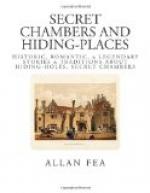How the unfortunate King rode from Dublin to Duncannon Fort, leaving his faithful followers and ill-fortunes behind him; got aboard the French vessel anchored there for his safety; and returned once more to the protection of the Grande Monarque at the palace of St. Germain, is an oft-told story of Stuart ingratitude.
[Illustration: ARMSCOT MANOR HOUSE, WORCESTERSHIRE]
[Illustration: ENTRANCE GATE, ARMSCOT MANOR HOUSE]
CHAPTER XI
MYSTERIOUS ROOMS, DEADLY PITS, ETC.
At the “Restoration House” previously mentioned there is a secret passage in the wall of an upper room; but though the Merry Monarch is, according to popular tradition, credited with a monopoly of hiding-places all over England, it is more than doubtful whether he had recourse to these exploits, in which he was so successful in 1651, upon such a joyful occasion, except, indeed, through sheer force of habit.
Even Cromwell’s name is connected with hiding-places! But it is difficult to conjecture upon what occasions his Excellency found it convenient to secrete himself, unless it was in his later days, when he went about in fear of assassination.
Hale House, Islington, pulled down in 1853, had a concealed recess behind the wainscot over the mantel-piece, formed by the curve of the chimney. In this, tradition says, the Lord Protector was hidden. Nor is this the solitary instance, for a dark hole in one of the gable ends of Cromwell House, Mortlake (taken down in 1860), locally known as “Old Noll’s Hole,” is said to have afforded him temporary accommodation when his was life in danger.[1] The residence of his son-in-law Ireton (Cromwell House) at Highgate contained a large secret chamber at the back of a cupboard in one of the upper rooms, and extended back twelve or fourteen feet, but the cupboard has now been removed and the space at the back converted into a passage.
[Footnote 1: See Faulkner’s History of Islington.]
The ancient manor house of Armscot, in an old-world corner of Worcestershire, contains in one of its gables a hiding-place entered through a narrow opening in the plaster wall, not unlike that at Ufton Court, and capable of holding many people. From the fact that George Fox was arrested in this house on October 17th, 1673, when he was being persecuted by the county magistrates, the story has come down to the yokels of the neighbourhood that “old Guy Fawkes, the first Quaker,” was hidden here! In his journal Fox mentions his arrest at Armscot after a “very large and precious meeting” in the barn close by; but we have no allusion to the hiding-place, for he appears to have been sitting in the parlour when Henry Parker, the Justice, arrived—indeed, George Fox was not the sort of man to have recourse to concealments, and owe his escape to a “priest’s hole.”
The suggestion of a sudden reverse in religious persecution driving a Quaker to such an extremity calls to mind an old farmstead where a political change from monarchy to commonwealth forced Puritan and cavalier consecutively to seek refuge in the secret chamber. This narrow hiding-place, beside the spacious fire-place, is pointed out in an ancient house in the parish of Hinchford, in Eastern Essex.




